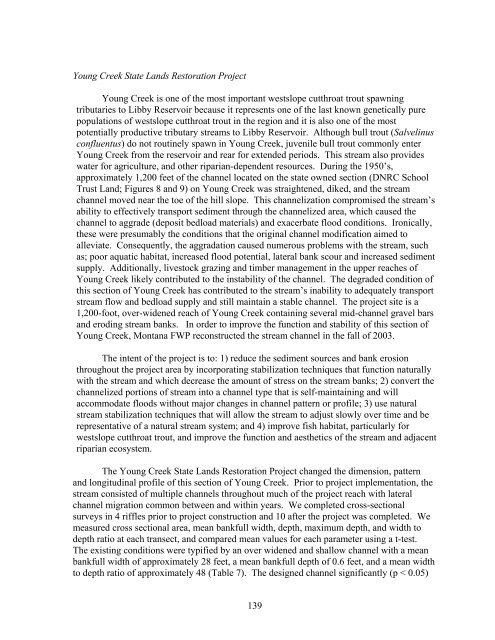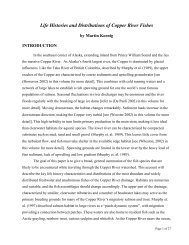Mitigation for the Construction and Operation of Libby Dam
Mitigation for the Construction and Operation of Libby Dam
Mitigation for the Construction and Operation of Libby Dam
Create successful ePaper yourself
Turn your PDF publications into a flip-book with our unique Google optimized e-Paper software.
Young Creek State L<strong>and</strong>s Restoration Project<br />
Young Creek is one <strong>of</strong> <strong>the</strong> most important westslope cutthroat trout spawning<br />
tributaries to <strong>Libby</strong> Reservoir because it represents one <strong>of</strong> <strong>the</strong> last known genetically pure<br />
populations <strong>of</strong> westslope cutthroat trout in <strong>the</strong> region <strong>and</strong> it is also one <strong>of</strong> <strong>the</strong> most<br />
potentially productive tributary streams to <strong>Libby</strong> Reservoir. Although bull trout (Salvelinus<br />
confluentus) do not routinely spawn in Young Creek, juvenile bull trout commonly enter<br />
Young Creek from <strong>the</strong> reservoir <strong>and</strong> rear <strong>for</strong> extended periods. This stream also provides<br />
water <strong>for</strong> agriculture, <strong>and</strong> o<strong>the</strong>r riparian-dependent resources. During <strong>the</strong> 1950’s,<br />
approximately 1,200 feet <strong>of</strong> <strong>the</strong> channel located on <strong>the</strong> state owned section (DNRC School<br />
Trust L<strong>and</strong>; Figures 8 <strong>and</strong> 9) on Young Creek was straightened, diked, <strong>and</strong> <strong>the</strong> stream<br />
channel moved near <strong>the</strong> toe <strong>of</strong> <strong>the</strong> hill slope. This channelization compromised <strong>the</strong> stream’s<br />
ability to effectively transport sediment through <strong>the</strong> channelized area, which caused <strong>the</strong><br />
channel to aggrade (deposit bedload materials) <strong>and</strong> exacerbate flood conditions. Ironically,<br />
<strong>the</strong>se were presumably <strong>the</strong> conditions that <strong>the</strong> original channel modification aimed to<br />
alleviate. Consequently, <strong>the</strong> aggradation caused numerous problems with <strong>the</strong> stream, such<br />
as; poor aquatic habitat, increased flood potential, lateral bank scour <strong>and</strong> increased sediment<br />
supply. Additionally, livestock grazing <strong>and</strong> timber management in <strong>the</strong> upper reaches <strong>of</strong><br />
Young Creek likely contributed to <strong>the</strong> instability <strong>of</strong> <strong>the</strong> channel. The degraded condition <strong>of</strong><br />
this section <strong>of</strong> Young Creek has contributed to <strong>the</strong> stream’s inability to adequately transport<br />
stream flow <strong>and</strong> bedload supply <strong>and</strong> still maintain a stable channel. The project site is a<br />
1,200-foot, over-widened reach <strong>of</strong> Young Creek containing several mid-channel gravel bars<br />
<strong>and</strong> eroding stream banks. In order to improve <strong>the</strong> function <strong>and</strong> stability <strong>of</strong> this section <strong>of</strong><br />
Young Creek, Montana FWP reconstructed <strong>the</strong> stream channel in <strong>the</strong> fall <strong>of</strong> 2003.<br />
The intent <strong>of</strong> <strong>the</strong> project is to: 1) reduce <strong>the</strong> sediment sources <strong>and</strong> bank erosion<br />
throughout <strong>the</strong> project area by incorporating stabilization techniques that function naturally<br />
with <strong>the</strong> stream <strong>and</strong> which decrease <strong>the</strong> amount <strong>of</strong> stress on <strong>the</strong> stream banks; 2) convert <strong>the</strong><br />
channelized portions <strong>of</strong> stream into a channel type that is self-maintaining <strong>and</strong> will<br />
accommodate floods without major changes in channel pattern or pr<strong>of</strong>ile; 3) use natural<br />
stream stabilization techniques that will allow <strong>the</strong> stream to adjust slowly over time <strong>and</strong> be<br />
representative <strong>of</strong> a natural stream system; <strong>and</strong> 4) improve fish habitat, particularly <strong>for</strong><br />
westslope cutthroat trout, <strong>and</strong> improve <strong>the</strong> function <strong>and</strong> aes<strong>the</strong>tics <strong>of</strong> <strong>the</strong> stream <strong>and</strong> adjacent<br />
riparian ecosystem.<br />
The Young Creek State L<strong>and</strong>s Restoration Project changed <strong>the</strong> dimension, pattern<br />
<strong>and</strong> longitudinal pr<strong>of</strong>ile <strong>of</strong> this section <strong>of</strong> Young Creek. Prior to project implementation, <strong>the</strong><br />
stream consisted <strong>of</strong> multiple channels throughout much <strong>of</strong> <strong>the</strong> project reach with lateral<br />
channel migration common between <strong>and</strong> within years. We completed cross-sectional<br />
surveys in 4 riffles prior to project construction <strong>and</strong> 10 after <strong>the</strong> project was completed. We<br />
measured cross sectional area, mean bankfull width, depth, maximum depth, <strong>and</strong> width to<br />
depth ratio at each transect, <strong>and</strong> compared mean values <strong>for</strong> each parameter using a t-test.<br />
The existing conditions were typified by an over widened <strong>and</strong> shallow channel with a mean<br />
bankfull width <strong>of</strong> approximately 28 feet, a mean bankfull depth <strong>of</strong> 0.6 feet, <strong>and</strong> a mean width<br />
to depth ratio <strong>of</strong> approximately 48 (Table 7). The designed channel significantly (p < 0.05)<br />
139
















